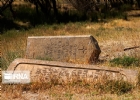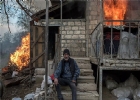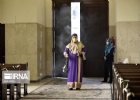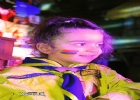
English :
18 Temmuz 2024
![]()
![]()
![]()
The 46th session of UNESCO’s World Heritage Committee will be held in Delhi, India from July 21 to 31, but very few people know that Armenians played an important role in the conservation and preservation of Indian heritage—from Joseph D. Beglar (Beglarian), who conserved the Bodh Gaya temple, to Sarkis Kachadourian, who discovered cave paintings at Bagh and preserved them. This article is dedicated to the life and legacy of Kachadourian.
The Scindia family had a phenomenally close relationship with Armenians. For 70 years, Armenian Colonel Jacob Petrus was the commander of Scindia’s army. Jacob also served the banker, Maharani of Gwalior Baiza Bai Scindia. Colonel Jacob’s army consisted of about 40 Armenian officers. He was held in such high esteem by, that the whole city of Gwalior went into mourning after his passing. During hiss funeral, which was largely attended by the nobility and the military officers of the state, 95-minute guns, equal in number to the veteran soldier’s age, were fired from the ramparts of the historic Gwalior Fort.
A number of Armenians who served under Colonel Jacob, some commissioned and others non-commissioned, amassed considerable fortunes. One such example, Major Johanness, left a fortune of nearly $6,000. Another, Woskan, returned to his native town of Erivan in Armenia, where he enjoyed a life of luxury and ease.
After the battles of Maharajpore and Punniar in 1843, which resulted in the disbanding of the huge army of the Scindia, most of the Armenians left Gwalior. The close ties between Scindia’s kingdom and Armenians continued, an example of which is the work of legendary Armenian artist Sarkis Katchadourian, known alternatively in India as Sarkis Kachadourian in Scindia’s kingdom.
Called the “Armenian Sorrow Singer” by Hovhannes Tumanyan, Andranik, and others, Kachadourian was born in the city of Malatia in Western Armenia. He studied at Karini Sanasaryan School, the Institute of Fine Arts in Rome, and the School of Decorative Arts in Paris. Surviving the horrors of the Armenian Genocide, he crossed Transcaucasia. Witnessing the tragic events that took place in his Homeland, these experiences became the main theme of his work. He was a member of the Union of Armenian Artists of Tiflis and the author of the first postage stamps of Soviet Armenia.
Kachadourian works of the first half of the 1920s are mostly devoted to the nature of Armenia, festivals, and emigration: “Ararat from Yerevan,” “Migrant Women,” “Distribution of Lunch,” “Cotton Picking in the Ararat Valley,” “Armenian Orphans in the Desert,” “Armenian Refugees,” “Varaga Monastery Holiday,” and “Sevana Island Churches.” His first attempt at reconstruction of fresco paintings was the reconstruction of old Persian frescoes, or rather their remnants, which exist in the ruined palaces of Ala Kapy Chehel Saloon in Isfahan. Then, he focused on India. He had a one-man exhibition at the Chicago Art Institute in January of 1943, titled “Mural Paintings from the Cave Temples of India in Replica by Sarkis Katchadourian.” But prior to the Chicago exhibition, he had an exhibition of some of his paintings in Maharaja Scindia’s kingdom in India.
An illustrated article, written by Major G. L. Khirwadkar, on Kachadourian’s contribution to art was published in Scindia’s newspaper, Jayaji Pratap, which was the largest circulated newspaper in Central India at the time. Kachadourian did a distinguished service to India in general and Scindia, in particular, by discovering some very beautiful fresco paintings on the walls of the famous Buddhist caves at Bagh in Scindia (Gwalior State).
These frescoes comprise of fascinating figures of Buddhas and Bodhisatvas and of men and women surrounded by garden scenery. They added, considerably, to the existing reputation of the Bagh caves as a repository of early Indian art. Kachadourian spent two very busy months at Bagh, making full-size copies of the wall paintings that were already known as well as those that had been newly discovered, and, in spite of illness due to the unhealthy climate of the place, he completed his work with brilliant success. He brought these copies to Gwalior.
According to former principal of Scindia School, Niyogi, perhaps the best part of the exhibition consisted of the reproductions of those paintings which Katchadourian said he had discovered himself in the Bagh Caves. The Buddha, for instance, or the panel design with drawings of figures inside, are superb. It may perhaps be that, in reproducing these, Katchadourian’s consciousness was untrammeled by the work of previous artists. In any case, Katchadourian’s genius for this type of work and his very original color sense are to be seen at their best. This is all the more remarkable in that he is not Indian and yet he can project his imagination into the work of essentially Indian artists dealing, 2,500 years ago, with Indian subjects.
The original Adilshahi—a dynasty of kings in India’s Deccan region—frescoes were painted on the walls of the water pavilion at Kumatgi, a district in Bijapur, during the reigns of the Sultans of Bijapur in the 16th and 17th centuries. The paintings depict the court life of Bijapur, and among them is a fine piece showing the game of polo as played at that time. The Gwalior exhibition of Kachadourian’s paintings had the privilege of exhibiting his Kumatgi frescoes for the first time, and the authorities of the Gwalior Museum of Maharaja Scindia had acquired this set of beautiful mural paintings for it.
The photos of Badami mural paintings, as reproduced by Kachadourian, were exhibited in the Gwalior exhibition in Scindia State and gave some idea of the beauty of the originals. Badami and Kumatgi frescoes were neglected, and Kachadourian was the first artist to attempt to reproduce and partially reconstruct them, thus bringing them to the attention of art lovers not only in India but all over the world. Badami and Kumatgi frescoes were painted in the 6th century, and so, along with Ajanta and Bagh, they are representatives of Hindu art of that period. The frescoes were in bad condition, and we owe a great debt to Kachadourian for his great service to the Indian art of copying and preserving previous works of art before time and climate obliterated their last traces.
According to Charles Faben Kelley, because “Mr. Sarkis Katchadourian, a gifted artist, was able to enter into the spirit of the Buddhist painters and spent four years in India working under difficult conditions to bring back a faithful record of their work, we can see for ourselves something of the grandeur of these little-known works. Those who are familiar with the original frescoes state that the fidelity of his work is extraordinary. Mr. Katchadourian was faced with a complex task: to find relatively undamaged portions of the paintings, to free them from surface dirt, and to estimate, in many cases, what the original colours must have been when time had been too savage in its erasures. The results are thrilling.”
Owing to the brittle nature of the rocks in which the Bagh caves are situated, the mural paintings of inestimable value in these caves were gradually destroyed, despite the great care taken by the Archaeological Department of Gwalior under Scindias. Thanks to Kachadourian, copies of these paintings were made, and the reproduction and reconstruction of these paintings by such a great artist as Kachadourian has been a very valuable addition to our art treasures.
The great Armenian artist worked at Bagh, and the subjects of King Scindia saw the results of his work at one of the most important and representative centers of ancient Indian art. Kachadourian visited Ajanta, Padukoli, Badami, Kumatgi, and Bagh. His reproductions of the world-famous Ajanta mural paintings are acclaimed as masterpieces in this sphere. Select paintings of the Ajanta caves by Kachadourian are now in the National Gallery of Armenia in Yerevan. Both the current President of the Indian Council of Cultural Relations, Dr. Vinay Sahasrabuddhe, and the current Foreign Minister of India, Dr. S. Jaishankar, posted on the social media platform X about the paintings they saw on their visits to Armenia, respectively.
It is well known that culture and art are a very strong way for two nations to come together as friends, and Armenians and Indians need to use them more often. In my previous articles, I’ve mentioned that Armenian culture in India is not just limited to the erstwhile presidency cities of the British Raj years, which most people know, but there were Armenians in the heart of India, in the region that we now call Madhya Pradesh. India and Armenia are coming closer day by day, because of our shared geopolitical interests. I hope that both nations will continue to work toward strengthening people-to-people ties.
Arunansh B. Goswami is an author, historian and advocate in the Supreme Court of India. He is a member of the Bar Association of Delhi and the Supreme Court Bar Association in India. Goswami has written on the history, culture and politics of various countries in several national and international publications.
The Scindia family had a phenomenally close relationship with Armenians. For 70 years, Armenian Colonel Jacob Petrus was the commander of Scindia’s army. Jacob also served the banker, Maharani of Gwalior Baiza Bai Scindia. Colonel Jacob’s army consisted of about 40 Armenian officers. He was held in such high esteem by, that the whole city of Gwalior went into mourning after his passing. During hiss funeral, which was largely attended by the nobility and the military officers of the state, 95-minute guns, equal in number to the veteran soldier’s age, were fired from the ramparts of the historic Gwalior Fort.
A number of Armenians who served under Colonel Jacob, some commissioned and others non-commissioned, amassed considerable fortunes. One such example, Major Johanness, left a fortune of nearly $6,000. Another, Woskan, returned to his native town of Erivan in Armenia, where he enjoyed a life of luxury and ease.
After the battles of Maharajpore and Punniar in 1843, which resulted in the disbanding of the huge army of the Scindia, most of the Armenians left Gwalior. The close ties between Scindia’s kingdom and Armenians continued, an example of which is the work of legendary Armenian artist Sarkis Katchadourian, known alternatively in India as Sarkis Kachadourian in Scindia’s kingdom.
Called the “Armenian Sorrow Singer” by Hovhannes Tumanyan, Andranik, and others, Kachadourian was born in the city of Malatia in Western Armenia. He studied at Karini Sanasaryan School, the Institute of Fine Arts in Rome, and the School of Decorative Arts in Paris. Surviving the horrors of the Armenian Genocide, he crossed Transcaucasia. Witnessing the tragic events that took place in his Homeland, these experiences became the main theme of his work. He was a member of the Union of Armenian Artists of Tiflis and the author of the first postage stamps of Soviet Armenia.
Kachadourian works of the first half of the 1920s are mostly devoted to the nature of Armenia, festivals, and emigration: “Ararat from Yerevan,” “Migrant Women,” “Distribution of Lunch,” “Cotton Picking in the Ararat Valley,” “Armenian Orphans in the Desert,” “Armenian Refugees,” “Varaga Monastery Holiday,” and “Sevana Island Churches.” His first attempt at reconstruction of fresco paintings was the reconstruction of old Persian frescoes, or rather their remnants, which exist in the ruined palaces of Ala Kapy Chehel Saloon in Isfahan. Then, he focused on India. He had a one-man exhibition at the Chicago Art Institute in January of 1943, titled “Mural Paintings from the Cave Temples of India in Replica by Sarkis Katchadourian.” But prior to the Chicago exhibition, he had an exhibition of some of his paintings in Maharaja Scindia’s kingdom in India.
An illustrated article, written by Major G. L. Khirwadkar, on Kachadourian’s contribution to art was published in Scindia’s newspaper, Jayaji Pratap, which was the largest circulated newspaper in Central India at the time. Kachadourian did a distinguished service to India in general and Scindia, in particular, by discovering some very beautiful fresco paintings on the walls of the famous Buddhist caves at Bagh in Scindia (Gwalior State).
These frescoes comprise of fascinating figures of Buddhas and Bodhisatvas and of men and women surrounded by garden scenery. They added, considerably, to the existing reputation of the Bagh caves as a repository of early Indian art. Kachadourian spent two very busy months at Bagh, making full-size copies of the wall paintings that were already known as well as those that had been newly discovered, and, in spite of illness due to the unhealthy climate of the place, he completed his work with brilliant success. He brought these copies to Gwalior.
According to former principal of Scindia School, Niyogi, perhaps the best part of the exhibition consisted of the reproductions of those paintings which Katchadourian said he had discovered himself in the Bagh Caves. The Buddha, for instance, or the panel design with drawings of figures inside, are superb. It may perhaps be that, in reproducing these, Katchadourian’s consciousness was untrammeled by the work of previous artists. In any case, Katchadourian’s genius for this type of work and his very original color sense are to be seen at their best. This is all the more remarkable in that he is not Indian and yet he can project his imagination into the work of essentially Indian artists dealing, 2,500 years ago, with Indian subjects.
The original Adilshahi—a dynasty of kings in India’s Deccan region—frescoes were painted on the walls of the water pavilion at Kumatgi, a district in Bijapur, during the reigns of the Sultans of Bijapur in the 16th and 17th centuries. The paintings depict the court life of Bijapur, and among them is a fine piece showing the game of polo as played at that time. The Gwalior exhibition of Kachadourian’s paintings had the privilege of exhibiting his Kumatgi frescoes for the first time, and the authorities of the Gwalior Museum of Maharaja Scindia had acquired this set of beautiful mural paintings for it.
The photos of Badami mural paintings, as reproduced by Kachadourian, were exhibited in the Gwalior exhibition in Scindia State and gave some idea of the beauty of the originals. Badami and Kumatgi frescoes were neglected, and Kachadourian was the first artist to attempt to reproduce and partially reconstruct them, thus bringing them to the attention of art lovers not only in India but all over the world. Badami and Kumatgi frescoes were painted in the 6th century, and so, along with Ajanta and Bagh, they are representatives of Hindu art of that period. The frescoes were in bad condition, and we owe a great debt to Kachadourian for his great service to the Indian art of copying and preserving previous works of art before time and climate obliterated their last traces.
According to Charles Faben Kelley, because “Mr. Sarkis Katchadourian, a gifted artist, was able to enter into the spirit of the Buddhist painters and spent four years in India working under difficult conditions to bring back a faithful record of their work, we can see for ourselves something of the grandeur of these little-known works. Those who are familiar with the original frescoes state that the fidelity of his work is extraordinary. Mr. Katchadourian was faced with a complex task: to find relatively undamaged portions of the paintings, to free them from surface dirt, and to estimate, in many cases, what the original colours must have been when time had been too savage in its erasures. The results are thrilling.”
Owing to the brittle nature of the rocks in which the Bagh caves are situated, the mural paintings of inestimable value in these caves were gradually destroyed, despite the great care taken by the Archaeological Department of Gwalior under Scindias. Thanks to Kachadourian, copies of these paintings were made, and the reproduction and reconstruction of these paintings by such a great artist as Kachadourian has been a very valuable addition to our art treasures.
The great Armenian artist worked at Bagh, and the subjects of King Scindia saw the results of his work at one of the most important and representative centers of ancient Indian art. Kachadourian visited Ajanta, Padukoli, Badami, Kumatgi, and Bagh. His reproductions of the world-famous Ajanta mural paintings are acclaimed as masterpieces in this sphere. Select paintings of the Ajanta caves by Kachadourian are now in the National Gallery of Armenia in Yerevan. Both the current President of the Indian Council of Cultural Relations, Dr. Vinay Sahasrabuddhe, and the current Foreign Minister of India, Dr. S. Jaishankar, posted on the social media platform X about the paintings they saw on their visits to Armenia, respectively.
It is well known that culture and art are a very strong way for two nations to come together as friends, and Armenians and Indians need to use them more often. In my previous articles, I’ve mentioned that Armenian culture in India is not just limited to the erstwhile presidency cities of the British Raj years, which most people know, but there were Armenians in the heart of India, in the region that we now call Madhya Pradesh. India and Armenia are coming closer day by day, because of our shared geopolitical interests. I hope that both nations will continue to work toward strengthening people-to-people ties.
Arunansh B. Goswami is an author, historian and advocate in the Supreme Court of India. He is a member of the Bar Association of Delhi and the Supreme Court Bar Association in India. Goswami has written on the history, culture and politics of various countries in several national and international publications.
Bu haber asbarez kaynağından gelmektedir.
Haber metninde yer alan görüşler haber kaynağı (asbarez) ve yazarına ait olup,
bolsohays.com sitesi haber hakkında herhangi bir görüş üstlenmemektedir.
Opinions expressed are those of the author(s)-(asbarez). They do not purport to reflect the opinions or views of bolsohays.com
Diğer Haberler
-
Photography of Ancient Armenia Featured in New 2026 Wall Calendar
-
Pope asks for prayers ahead of visit to Türkiye and Lebanon
-
Armenia will step up its efforts toward membership in the European Union in 2026
-
Economy Minister discussed rebranding of Armenian brandy with producers
-
Aleppo - Yerevan - Aleppo
-
Mirzoyan: Armenia citizens should live in Armenia, Azerbaijan citizens should live in Azerbaijan
-
Armenia will officially receive the European Union`s visa liberalization action plan in the coming
-
Armenia might achieve visa-free travel to the European Union within two years
-
Armenia opens transit route between Azerbaijan and Türkiye
-
Armenia invites Erdogan, Aliyev to 2026 European Political Community Summit
-
Patrick Fiori to Compete in Eurovision 2027?
-
Armenian Wines Voskevaz Karasi Areni Noir And Haghtanak Win Gold at Prestigious U.S. Wine Competitio
Foto Galeri Tüm Galeriler
Video Galeri Tüm Videolar
-
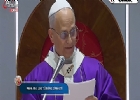
Papa XIV. Leo`nun Türkiye Ziyareti | Volkswagen Arena Efkaristiya Ayini
-
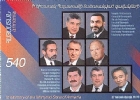
Parliament Shooting in Armenia, October 27, 1999
-

Albert - Brave Heart | ???????? Armenia | Official Music Video | Junior Eurovision 2025
-
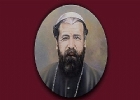
Սրբադասման Սուրբ Պատարագ եւ Հրեշտակ Տեառն Մարեմեան աղօթք 19 հոկտեմբեր 2025 – Լեւոն ԺԴ. Քահանայապետ
Anket Tüm Anketler
Günün Sözü
Կեանքի ընթացքին, մարդիկ պէտք ունին բաժակ մը գիտութիւն, տակաո մը խոհեմութիւն եւ ովկիանոս մը համբերութիւն։











